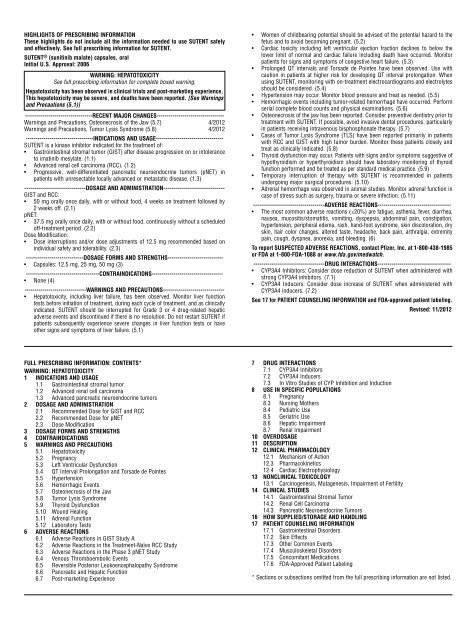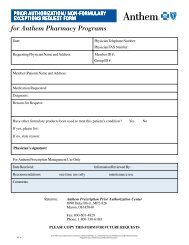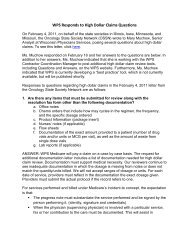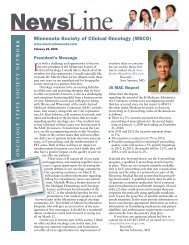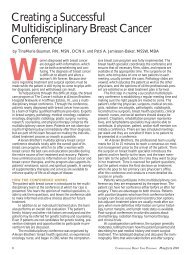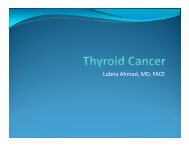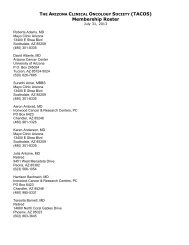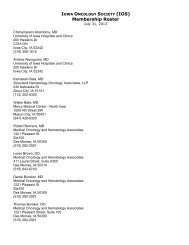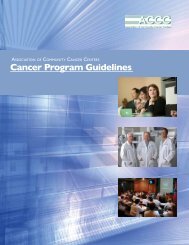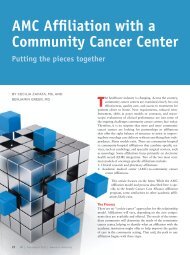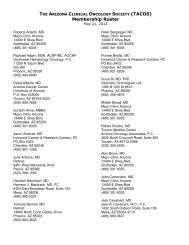2013 Patient Assistance and Reimbursement Guide - Association of ...
2013 Patient Assistance and Reimbursement Guide - Association of ...
2013 Patient Assistance and Reimbursement Guide - Association of ...
Create successful ePaper yourself
Turn your PDF publications into a flip-book with our unique Google optimized e-Paper software.
HIGHLIGHTS OF PRESCRIBING INFORMATION<br />
These highlights do not include all the information needed to use SUTENT safely<br />
<strong>and</strong> effectively. See full prescribing information for SUTENT.<br />
SUTENT ® (sunitinib malate) capsules, oral<br />
Initial U.S. Approval: 2006<br />
WARNING: HEPATOTOXICITY<br />
See full prescribing information for complete boxed warning.<br />
Hepatotoxicity has been observed in clinical trials <strong>and</strong> post-marketing experience.<br />
This hepatotoxicity may be severe, <strong>and</strong> deaths have been reported. [See Warnings<br />
<strong>and</strong> Precautions (5.1)]<br />
----------------------------------RECENT MAJOR CHANGES----------------------------------<br />
Warnings <strong>and</strong> Precautions, Osteonecrosis <strong>of</strong> the Jaw (5.7) 4/2012<br />
Warnings <strong>and</strong> Precautions, Tumor Lysis Syndrome (5.8) 4/2012<br />
----------------------------------INDICATIONS AND USAGE----------------------------------<br />
SUTENT is a kinase inhibitor indicated for the treatment <strong>of</strong>:<br />
• Gastrointestinal stromal tumor (GIST) after disease progression on or intolerance<br />
to imatinib mesylate. (1.1)<br />
• Advanced renal cell carcinoma (RCC). (1.2)<br />
• Progressive, well-differentiated pancreatic neuroendocrine tumors (pNET) in<br />
patients with unresectable locally advanced or metastatic disease. (1.3)<br />
-------------------------------DOSAGE AND ADMINISTRATION-------------------------------<br />
GIST <strong>and</strong> RCC:<br />
• 50 mg orally once daily, with or without food, 4 weeks on treatment followed by<br />
2 weeks <strong>of</strong>f. (2.1)<br />
pNET:<br />
• 37.5 mg orally once daily, with or without food, continuously without a scheduled<br />
<strong>of</strong>f-treatment period. (2.2)<br />
Dose Modification:<br />
• Dose interruptions <strong>and</strong>/or dose adjustments <strong>of</strong> 12.5 mg recommended based on<br />
individual safety <strong>and</strong> tolerability. (2.3)<br />
-----------------------------DOSAGE FORMS AND STRENGTHS----------------------------<br />
• Capsules: 12.5 mg, 25 mg, 50 mg (3)<br />
-------------------------------------CONTRAINDICATIONS------------------------------------<br />
• None (4)<br />
-------------------------------WARNINGS AND PRECAUTIONS-------------------------------<br />
• Hepatotoxicity, including liver failure, has been observed. Monitor liver function<br />
tests before initiation <strong>of</strong> treatment, during each cycle <strong>of</strong> treatment, <strong>and</strong> as clinically<br />
indicated. SUTENT should be interrupted for Grade 3 or 4 drug-related hepatic<br />
adverse events <strong>and</strong> discontinued if there is no resolution. Do not restart SUTENT if<br />
patients subsequently experience severe changes in liver function tests or have<br />
other signs <strong>and</strong> symptoms <strong>of</strong> liver failure. (5.1)<br />
• Women <strong>of</strong> childbearing potential should be advised <strong>of</strong> the potential hazard to the<br />
fetus <strong>and</strong> to avoid becoming pregnant. (5.2)<br />
• Cardiac toxicity including left ventricular ejection fraction declines to below the<br />
lower limit <strong>of</strong> normal <strong>and</strong> cardiac failure including death have occurred. Monitor<br />
patients for signs <strong>and</strong> symptoms <strong>of</strong> congestive heart failure. (5.3)<br />
• Prolonged QT intervals <strong>and</strong> Torsade de Pointes have been observed. Use with<br />
caution in patients at higher risk for developing QT interval prolongation. When<br />
using SUTENT, monitoring with on-treatment electrocardiograms <strong>and</strong> electrolytes<br />
should be considered. (5.4)<br />
• Hypertension may occur. Monitor blood pressure <strong>and</strong> treat as needed. (5.5)<br />
• Hemorrhagic events including tumor-related hemorrhage have occurred. Perform<br />
serial complete blood counts <strong>and</strong> physical examinations. (5.6)<br />
• Osteonecrosis <strong>of</strong> the jaw has been reported. Consider preventive dentistry prior to<br />
treatment with SUTENT. If possible, avoid invasive dental procedures, particularly<br />
in patients receiving intravenous bisphosphonate therapy. (5.7)<br />
• Cases <strong>of</strong> Tumor Lysis Syndrome (TLS) have been reported primarily in patients<br />
with RCC <strong>and</strong> GIST with high tumor burden. Monitor these patients closely <strong>and</strong><br />
treat as clinically indicated. (5.8)<br />
• Thyroid dysfunction may occur. <strong>Patient</strong>s with signs <strong>and</strong>/or symptoms suggestive <strong>of</strong><br />
hypothyroidism or hyperthyroidism should have laboratory monitoring <strong>of</strong> thyroid<br />
function performed <strong>and</strong> be treated as per st<strong>and</strong>ard medical practice. (5.9)<br />
• Temporary interruption <strong>of</strong> therapy with SUTENT is recommended in patients<br />
undergoing major surgical procedures. (5.10)<br />
• Adrenal hemorrhage was observed in animal studies. Monitor adrenal function in<br />
case <strong>of</strong> stress such as surgery, trauma or severe infection. (5.11)<br />
------------------------------------ADVERSE REACTIONS-------------------------------------<br />
• The most common adverse reactions (≥20%) are fatigue, asthenia, fever, diarrhea,<br />
nausea, mucositis/stomatitis, vomiting, dyspepsia, abdominal pain, constipation,<br />
hypertension, peripheral edema, rash, h<strong>and</strong>-foot syndrome, skin discoloration, dry<br />
skin, hair color changes, altered taste, headache, back pain, arthralgia, extremity<br />
pain, cough, dyspnea, anorexia, <strong>and</strong> bleeding. (6)<br />
To report SUSPECTED ADVERSE REACTIONS, contact Pfizer, Inc. at 1-800-438-1985<br />
or FDA at 1-800-FDA-1088 or www.fda.gov/medwatch.<br />
------------------------------------DRUG INTERACTIONS-------------------------------------<br />
• CYP3A4 Inhibitors: Consider dose reduction <strong>of</strong> SUTENT when administered with<br />
strong CYP3A4 inhibitors. (7.1)<br />
• CYP3A4 Inducers: Consider dose increase <strong>of</strong> SUTENT when administered with<br />
CYP3A4 inducers. (7.2)<br />
See 17 for PATIENT COUNSELING INFORMATION <strong>and</strong> FDA-approved patient labeling.<br />
Revised: 11/2012<br />
FULL PRESCRIBING INFORMATION: CONTENTS*<br />
WARNING: HEPATOTOXICITY<br />
1 INDICATIONS AND USAGE<br />
1.1 Gastrointestinal stromal tumor<br />
1.2 Advanced renal cell carcinoma<br />
1.3 Advanced pancreatic neuroendocrine tumors<br />
2 DOSAGE AND ADMINISTRATION<br />
2.1 Recommended Dose for GIST <strong>and</strong> RCC<br />
2.2 Recommended Dose for pNET<br />
2.3 Dose Modification<br />
3 DOSAGE FORMS AND STRENGTHS<br />
4 CONTRAINDICATIONS<br />
5 WARNINGS AND PRECAUTIONS<br />
5.1 Hepatotoxicity<br />
5.2 Pregnancy<br />
5.3 Left Ventricular Dysfunction<br />
5.4 QT Interval Prolongation <strong>and</strong> Torsade de Pointes<br />
5.5 Hypertension<br />
5.6 Hemorrhagic Events<br />
5.7 Osteonecrosis <strong>of</strong> the Jaw<br />
5.8 Tumor Lysis Syndrome<br />
5.9 Thyroid Dysfunction<br />
5.10 Wound Healing<br />
5.11 Adrenal Function<br />
5.12 Laboratory Tests<br />
6 ADVERSE REACTIONS<br />
6.1 Adverse Reactions in GIST Study A<br />
6.2 Adverse Reactions in the Treatment-Naïve RCC Study<br />
6.3 Adverse Reactions in the Phase 3 pNET Study<br />
6.4 Venous Thromboembolic Events<br />
6.5 Reversible Posterior Leukoencephalopathy Syndrome<br />
6.6 Pancreatic <strong>and</strong> Hepatic Function<br />
6.7 Post-marketing Experience<br />
7 DRUG INTERACTIONS<br />
7.1 CYP3A4 Inhibitors<br />
7.2 CYP3A4 Inducers<br />
7.3 In Vitro Studies <strong>of</strong> CYP Inhibition <strong>and</strong> Induction<br />
8 USE IN SPECIFIC POPULATIONS<br />
8.1 Pregnancy<br />
8.3 Nursing Mothers<br />
8.4 Pediatric Use<br />
8.5 Geriatric Use<br />
8.6 Hepatic Impairment<br />
8.7 Renal Impairment<br />
10 OVERDOSAGE<br />
11 DESCRIPTION<br />
12 CLINICAL PHARMACOLOGY<br />
12.1 Mechanism <strong>of</strong> Action<br />
12.3 Pharmacokinetics<br />
12.4 Cardiac Electrophysiology<br />
13 NONCLINICAL TOXICOLOGY<br />
13.1 Carcinogenesis, Mutagenesis, Impairment <strong>of</strong> Fertility<br />
14 CLINICAL STUDIES<br />
14.1 Gastrointestinal Stromal Tumor<br />
14.2 Renal Cell Carcinoma<br />
14.3 Pancreatic Neuroendocrine Tumors<br />
16 HOW SUPPLIED/STORAGE AND HANDLING<br />
17 PATIENT COUNSELING INFORMATION<br />
17.1 Gastrointestinal Disorders<br />
17.2 Skin Effects<br />
17.3 Other Common Events<br />
17.4 Musculoskeletal Disorders<br />
17.5 Concomitant Medications<br />
17.6 FDA-Approved <strong>Patient</strong> Labeling<br />
* Sections or subsections omitted from the full prescribing information are not listed.


